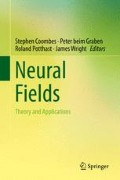Abstract
Mathematical treatments of the dynamics of neural fields become much simpler when the Heaviside function is used as an activation function. This is because the dynamics of an excited or active region reduce to the dynamics of the boundary. We call this regime the Heaviside world. Here, we visit the Heaviside world and briefly review bump dynamics in the 1D, 1D two-layer, and 2D cases. We further review the dynamics of forming topological maps by self-organization. The Heaviside world is useful for studying the learning or self-organization equation of receptive fields. The stability analysis shows the formation of a continuous map or the emergence of a block structure responsible for columnar microstructures. The stability of the Kohonen map is also discussed.
Access this chapter
Tax calculation will be finalised at checkout
Purchases are for personal use only
References
Amari, S.: Characteristics of randomly connected threshold-element networks and network systems. Proc. IEEE 59(1), 35–47 (1971)
Amari, S.: Characteristics of random nets of analog neuron-like elements. IEEE Trans. Syst. Man Cybern. (SMC) 2(5), 643–657 (1972). (Also Vemri, V. (ed.): Artificial Neural Networks Theoretical Concepts. IEEE Computer Society (1988))
Amari, S.: Dynamics of pattern formation in lateral-inhibition type neural fields. Biol. Cybern. 27, 77–87 (1977)
Amari, S.: Topographic organization of nerve fields. Bull. Math. Biol. 42, 339–364 (1980)
Bressloff, P.C.: Spatiotemporal dynamics of continuum neural fields. J. Phys. A 45, 1–109 (2012)
Bressloff, P.C., Coombes, S.: Neural ‘bubble’ dynamics revisited. Cogn. Comput. 5, 281–294 (2013)
Coombes, S., Schmidt, H., Bojak, I.: Interface dynamics in planar neural field models. J. Math. Neurosci. 2, 9 (2012)
Folias, S.E.: Nonlinear analysis of breathing pulses in synaptically coupled excitable neural activity. J. Comput. Neurosci. 11, 121–134 (2011)
Folias, S.E., Bressloff, P.C.: Breathing pulses in an excitatory neural network. SIAM J. Appl. Dyn. Syst. 3, 378–407 (1974)
Fung, C.A., Wong, M., Wang, H., Wu, S.: Dynamical synapses enhance neural information processing: Gracefulness, accuracy and mobility. Neural Comput. 24, 1147–1185 (2012)
Kohonen, T.: Self-organized formation of topologically correct feature maps. Biol. Cybern. 43, 59–69 (1982)
Kurata, K.: Formation of information representation by self-organization. In: Japanese Association of Industrial Technology (eds.) Basics of Neurocomputing, chap. 5. Japanese Association of Industrial Technology, Tokyo (1989). in Japanese
Lu, Y., Sato, Y., Amari, S.: Travelling bumps and their collisions in a two-dimensional neural field. Neural Comput. 23, 1248–1260 (2011)
Seung, H.S.: Continuous attractors and oculomotor control. Neural Netw. 11, 1253–58 (1998)
Takeuchi, A., Amari, S.: Formation of topographic maps and columnar microstructures. Biol. Cybern. 35, 63–72 (1979)
von der Malsburg, C.: Self-organization of orientation sensitivity and columns in the visual cortex. Kybernetik 14, 85–100 (1973)
Willshaw, D.J., von der Malsburg, C.: How patterned neural connections can be set up by self-organization. Proc. R. Soc. B 194, 431–445 (1976)
Wilson, H.R., Cowan, J.D.: Excitatory and inhibitory interactions in localized populations of model neurons. Biophys. J. 12, 1–24 (1972)
Wu, S., Amari, S.: Computing with continuous attractors: Stability and on-line aspects. Neural Comput. 17, 2215–2239 (2005)
Author information
Authors and Affiliations
Corresponding author
Editor information
Editors and Affiliations
Rights and permissions
Copyright information
© 2014 Springer-Verlag Berlin Heidelberg
About this chapter
Cite this chapter
Amari, Si. (2014). Heaviside World: Excitation and Self-Organization of Neural Fields. In: Coombes, S., beim Graben, P., Potthast, R., Wright, J. (eds) Neural Fields. Springer, Berlin, Heidelberg. https://doi.org/10.1007/978-3-642-54593-1_3
Download citation
DOI: https://doi.org/10.1007/978-3-642-54593-1_3
Published:
Publisher Name: Springer, Berlin, Heidelberg
Print ISBN: 978-3-642-54592-4
Online ISBN: 978-3-642-54593-1
eBook Packages: Mathematics and StatisticsMathematics and Statistics (R0)

